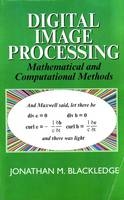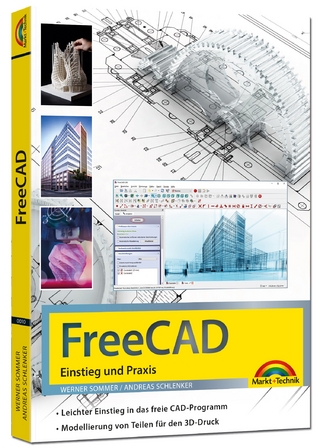
Digital Image Processing
Horwood Publishing Ltd (Verlag)
978-1-898563-49-5 (ISBN)
- Keine Verlagsinformationen verfügbar
- Artikel merken
Jonathan M. Blackledge, Loughborough University, UK
About the Author
Foreword
Preface
Acknowledgements
Notation
Alphabetical
Greek
Operators
Glossary
Mathematical and Statistical
Computer Science
Organizational and Standards
Introduction
Imaging Science
Signals and Images
Image Formation
Image Information
Image Analysis
Digital Image Processing
Fundamental Problems
About this Book
Summary of Important Results
Part I: Mathematical and Computational Background
Chapter 1: Vector Fields
1.1 Scalar Fields
1.2 Vector Fields
1.3 The Divergence Theorem
1.4 Summary of Important Results
Chapter 2: 2D Fourier Theory
2.1 The 2D Complex Fourier Series
2.2 The 2D Delta Function
2.3 The 2D Fourier Transform
2.4 Physical Representation
2.5 The Spectrum
2.6 Definitions and Notation
2.7 Some Important Results
2.8 Some Important Theorems
2.9 Convolution and Correlation
2.10 Convolution and Correlation Theorems
2.11 Other Integral Transforms
2.12 Discussion
2.13 Summary of Important Results
Chapter 3: The 2D DFT, FFT and FIR Filter
3.1 The Discrete Fourier Transform
3.2 The Sampling Theorem
3.3 The Discrete Spectrum of a Digital Image
3.4 The Fast Fourier Transform
3.5 The Imaging Equation and Convolution in 2D
3.6 The Finite Impulse Response Filter
3.7 Origin of the Imaging Equation
3.8 Summary of Important Results
Chapter 4: Field and Wave Equations
4.1 The Langevin Equation
4.2 Maxwell’s Equations
4.3 General Solution to Maxwell’s (Microscopic) Equations
4.4 The Macroscopic Maxwell’s Equations
4.5 EM Waves in a Homogeneous Medium
4.6 EM Waves in an Inhomogeneous Medium
4.7 Elastic Field Equations
4.8 Inhomogeneous Elastic Wave Equation
4.9 Acoustic Field Equations
4.10 Discussion
4.11 Summary of Important Results
Chapter 5: Green Functions
5.1 Overview
5.2 Introduction to the Green Function
5.3 The Time Independent Wave Operator
5.4 Wavefields Generated by Sources
5.5 Time Dependent Green Function
5.6 Time Dependent Sources
5.7 Green Function Solution to Maxwell’s Equation
5.8 The Diffusion Equation
5.9 Green Function Solution to the Diffusion Equation
5.10 The Laplace and Poisson Equations
5.11 Discussion
5.12 Summary of Important Results
Problems: Part I
Part II: Imaging Systems Modelling
Chapter 6: Scattering Theory
6.1 The Schrödinger and Helmholtz Equations
6.2 Solution to the Helmholtz Equation
6.3 Examples of Born Scattering
6.4 Other Approximation Methods
6.5 The Born Series
6.6 Inverse Scattering
6.7 Surface Scattering Theory
6.8 Summary of Important Results
Chapter 7: Imaging of Layered Media
7.1 Pulse-Echo Imaging
7.2 EM Imaging of a Layered Dielectric
7.3 Acoustic Imaging of a Layered Material
7.4 Side-band Systems and Demodulation
7.5 Some Applications
7.6 Case Study: Imaging the Ionosphere
7.7 Case Study: Radar Plasma Screening
7.8 Summary of Important Results
Chapter 8: Projection Tomography
8.1 Basic Principles
8.2 Projection Tomography and Scattering Theory
8.3 The Radon Transform
8.4 Back-Projection PSF
8.5 The Central Slice Theorem
8.6 Numerical Methods
8.7 The Hough Transform
8.8 Non-separable Image Processing
8.9 Summary of Important Results
Chapter 9: Diffraction Tomography
9.1 Diffraction Tomography using CW Fields
9.2 Pulse Mode Diffraction Tomography
9.3 The Diffraction Slice Theorem
9.4 Quantitative Diffraction Tomography
9.5 EM Diffraction Tomography
9.6 Case Study: Simulation of an Ultrasonic B-Scan
9.7 Summary of Important Results
Chapter 10: Synthetic Aperture Imaging
10.1 Synthetic Aperture Radar
10.2 Principles of SAR
10.3 Electromagnetic Scattering Model for SAR
10.4 Case Study: The ‘Sea Spikes’ Problem
10.5 Quantitative Imaging with SAR
10.6 Synthetic Aperture Sonar
10.7 Summary of Important Results
Chapter 11: Optical Image Formation
11.1 Optical Diffraction
11.2 The Fourier Transforming Properties of a Lens
11.3 Linear Systems
11.4 Images of Lines and Edges
11.5 Linearity of Optical Imaging Systems
11.6 Coherent Image Formation
11.7 Phase Contrast Imaging
11.8 Incoherent Image Formation
11.9 Coherent and Incoherent Optical Imaging
11.10 Optical Beams
11.11 The Paraxial Wave Equation
11.12 Holographic Imaging
11.13 Case Study: Digital Watermarking
11.14 Summary of Important Results
Problems: Part II
Part III: Digital Image Processing Methods
Chapter 12: Image Restoration and Reconstruction
12.1 Introduction
12.2 Image Restoration
12.3 The Inverse Filter
12.4 The Wiener Filter
12.5 The Power Spectrum Equalization Filter
12.6 The Matched Filter
12.7 Maximum Entropy Deconvolution
12.8 Constrained Deconvolution
12.9 Phase Reconstruction and Phase Imaging
12.10 Non-stationary Deconvolution
12.11 Discussion
12.12 Summary of Important Results
Chapter 13: Reconstruction of Band-limited Images
13.1 The Gerchberg-Papoulis Method
13.2 Incorporation of a Priori Information
13.3 Example Demonstration and Applications
13.4 Error Reduction Algorithm
13.5 Discussion
13.6 Summary of Important Results
Chapter 14: Bayesian Estimation Methods
14.1 Introduction to Probability and Bayes Rule
14.2 The Maximum Likelihood Filter
14.3 The Maximum a Posteriori Filter
14.4 Super Resolution using Bayesian Methods
14.5 Summary of Important Results
Chapter 15: Image Enhancement
15.1 Basic Transforms
15.2 Histogram Equalization
15.3 Homomorphic Filtering
15.4 Light Diffusion and the High Emphasis Filter
15.5 Noise Reduction
15.6 The Median Filter
15.7 Summary of Important Results
Problems: Part III
Part IV: Pattern Recognition and Computer Vision
Chapter 16: Segmentation and Edge Detection
16.1 Correlation and the Auto-covariance Function
16.2 Thresholding
16.3 Edge Detection
16.4 Second Order Edge Detection
16.5 The Marr-Hildreth Method
16.6 Pixel Clustering
16.7 Clustering Tools
16.8 Hierarchical Data Structures
16.9 Summary of Important Results
Chapter 17: Statistical Modelling and Analysis
17.1 Random Scattering Theory
17.2 Statistical Modelling Methods
17.3 Phase Distribution Analysis
17.4 Fully Coherent Scattering Processes
17.5 Statistical Moments
17.6 Noise and Statistical Tests
17.7 Texture Segmentation
17.8 Summary of Important Results
Chapter 18: Fractal Images and Image Processing
18.1 Introduction
18.2 Geometry and Dimension
18.3 Fractal Curves and Fractal Signals
18.4 Random Scaling Fractals and Texture
18.5 Methods of Computing the Fractal Dimension
18.6 The Fourier and Fractal Dimensions
18.7 Other Dimensions and Higher Order Fractals
18.8 The Information Dimension
18.9 The Lyapunov Dimension
18.10 Fractal Images and Mandelbrot Surfaces
18.11 Generalized Random Scaling Fractal (RSF) Models
18.12 Multi-Fractal Analysis
18.13 Case Study: Fractional Light Diffusion
18.14 Summary of Important Results
Chapter 19: Coding and Compression
19.1 The Reasons for Compression
19.2 Lossless Coding Methods
19.3 Lossy Coding Methods
19.4 Fractal Image Compression
19.5 Properties and Features
19.6 Improved Fractal Compression
19.7 Compression Conscious Operations
19.8 Fractal Texture Maps
19.9 Summary of Important Results
Problems: Part IV
Summary
Appendix A: Solutions to Problems
Solutions to Problems: Part I
Solutions to Part II
Solutions to Problems: Part III
Solutions to Problems: Part IV
Appendix B: Supplementary Problems
Appendix C: Fourier Transform of a Fractal
Appendix D: I/O and Graphics Utilities
Reading and Writing Images to and From a Named Data File
Displaying a Digital Image
Index
| Erscheint lt. Verlag | 30.11.2005 |
|---|---|
| Reihe/Serie | Woodhead Publishing Series in Electronic and Optical Materials |
| Sprache | englisch |
| Gewicht | 1200 g |
| Themenwelt | Informatik ► Grafik / Design ► Digitale Bildverarbeitung |
| Informatik ► Theorie / Studium ► Künstliche Intelligenz / Robotik | |
| ISBN-10 | 1-898563-49-7 / 1898563497 |
| ISBN-13 | 978-1-898563-49-5 / 9781898563495 |
| Zustand | Neuware |
| Informationen gemäß Produktsicherheitsverordnung (GPSR) | |
| Haben Sie eine Frage zum Produkt? |
aus dem Bereich


